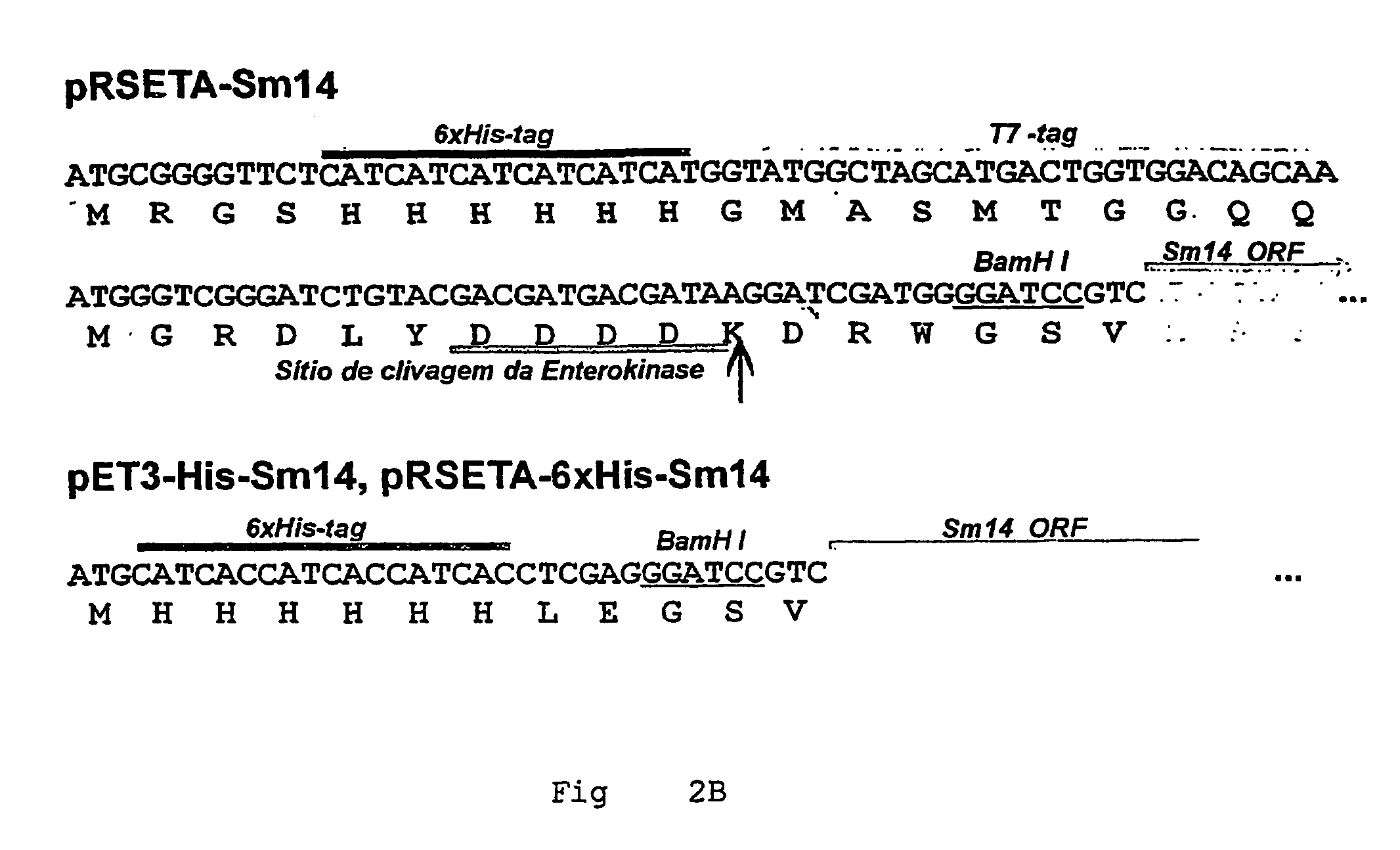Helminth-derived antigens having capacity of providing protection against parasites
a technology of antigens and helminths, which is applied in the field of antigenic helminth-derived materials, can solve the problems of liver cirrhosis and death, serious economic losses over the world, and high morbidity
- Summary
- Abstract
- Description
- Claims
- Application Information
AI Technical Summary
Benefits of technology
Problems solved by technology
Method used
Image
Examples
example 1
[0115] Example 1 presents a comparative table among protection results obtained in mice, with several forms mutants constructed and obtained from the rSm14.
[0116] The vaccination protocol was performed as below.
Group0 day7 days28 days88 days133 daysVaccinatedVVVCPControlCP
Where:
V means vaccination;
C means challenge; and
P means perfusion (for recovery adult worms and evaluation of the protection).
[0117] Comparative Table
AdultWormsProtec-Experimental GroupsNMinMaxX ± SEMtionSm14TC + Ribi (1 exp.)*121228 18.6 + 0.4524.10%Sm14TC + Alum (4 exp)47226 13.8 + 0.1443.70%Sm14TC (3 exp)34636 18.3 + 0.1925.30%Sm14AC + Alum (1 exp)1463419.4 + 0.620.80%Sm14AC (1 exp)13103620.1 + 0.617.90%Sm14MS + Alum (2 exp)2222411.2 + 0.354.30%Sm14MS (1 exp)1502010.6 + 0.456.70%Sm14MV + Alum (2 exp)2822211.8 + 0.551.80%Sm14MV (1 exp)1262415.2 + 0.538.00%Sm14TI + Alum (2 exp)2842410.6 + 0.256.70%Sm14TI (1 exp)1242214.0 + 0.443.00%Sm14MC + Alum (2 exp)250208.16 + 0.266.70%Sm14MC (1 exp)1362012.9 + 0.347....
example 2
[0120] Example 2 presents the protection results obtained in mice, with the several mutant forms constructed and obtained from the rSm14. The methodology used in Example 2 was identical to Example 1.
[0121] A hundred metacercaria / mouse were used in the challenge. The vaccination was performed using three 10-μg doses of the protein, according to the same protocol described in Example 1.
[0122] Results
Sm14TCSm14MSSm14MVSm14TISm14MCAdjuvantPBS22460101026460121046660121446682121461068416146128841616612810416168128104161881412106181812 1414106202014 9.414128222214 44.70%14128222216 161610262218 189.384615102822 8.5714299.85714344.80%1017.571431749.60%42.40%5.0666670%70.20%
[0123] The whole numbers (0 to 28) represent the number of worms recovered, per mouse and per vaccinated group. The mean result (worms / mouse average) found (i.e., Sm14TC 8.571429) is obtained through the sum of the number of recovered worms divided by 14 (n=14).
example 3
[0124] Example 3 shows the data from the experiment of vaccination in mice with mutants of the Sm14 protein against F. Hepática. The challenge was performed using 3 metacercaria. The numeric results are presented in the following way:
[0125] Number of animal with liver lesion / Number of the living animals at the end of the experiment.
No. of animalNo. of the livingExp.Proteinwith liver lesionanimals at the end1TI (T20C62)2182A20C624183T20C624174M20C625205M20S624156M20V62716Control—1717
[0126] No antigens were administered for the control group that only received the infection simultaneously to the vaccinated groups.
[0127] From the results above, it is possible to observe that mutant forms of the Experiments 5 and 6, more stable than the wild form (Cys62), have provided protection for vaccinated animals. It is worth pointing out that although the mutant forms have not reached high rates of protection in its wild form (Cys62), these new mutant forms can perfectly be obtained in large-...
PUM
| Property | Measurement | Unit |
|---|---|---|
| Temperature | aaaaa | aaaaa |
| Temperature | aaaaa | aaaaa |
| Fraction | aaaaa | aaaaa |
Abstract
Description
Claims
Application Information
 Login to View More
Login to View More - R&D
- Intellectual Property
- Life Sciences
- Materials
- Tech Scout
- Unparalleled Data Quality
- Higher Quality Content
- 60% Fewer Hallucinations
Browse by: Latest US Patents, China's latest patents, Technical Efficacy Thesaurus, Application Domain, Technology Topic, Popular Technical Reports.
© 2025 PatSnap. All rights reserved.Legal|Privacy policy|Modern Slavery Act Transparency Statement|Sitemap|About US| Contact US: help@patsnap.com



